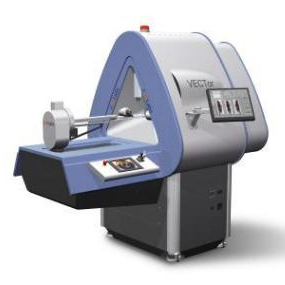El nuevo dispositivo ensambla el alto-res PET con SPECT
por Brendon Nafziger, DOTmed News Associate Editor | June 03, 2010

A preclinical hybrid
PET/SPECT device, the
VECTor allows resolutions
to half a millimeter
(Image courtesy of MI Labs.)
PET/SPECT device, the
VECTor allows resolutions
to half a millimeter
(Image courtesy of MI Labs.)
A new device combines high-resolution PET with SPECT scanners to allow scientists working on cancer and brain research with small animals to see functional details down to a half millimeter in size.
Dubbed the Versatile Emission Computed Tomography, or VECTor, the device, developed by researchers at the Delft University of Technology in the Netherlands and the company Molecular Imaging Labs, could help scientists find cancer treatments.
"In SPECT it's already possible to image different molecules simultaneously because you can label them with an isotope with a different energy and the SPECT system is able to detect the energy of each gamma ray that is emitted by a molecule," said Freek J. Beekman, head of the radiation, detection and medical imaging section at TU-Delft, CEO of MI Labs and designer of the device. "With our new technique, you can combine the whole huge set of PET molecules so the number of combinations gets hundreds of times bigger."

 While some systems combine SPECT and PET on a single gantry, the new device is one of the first to offer real simultaneous imaging, Beekman said. This makes it cheaper than buying two systems, and able to offer exactly aligned images, he said.
While some systems combine SPECT and PET on a single gantry, the new device is one of the first to offer real simultaneous imaging, Beekman said. This makes it cheaper than buying two systems, and able to offer exactly aligned images, he said.
"It's going to be used very often in cancer research," Beekman noted. "I expect there to be a big market also in brain research, because it's very hard to get in mice sufficient resolution with ring PET systems, with traditional PET imaging."
The SPECT half of the device is made up of an Ultra-high resolution Single Photon Emission Computed Tomographer, or U-SPECT, a kind of high-resolution SPECT scanner developed by Beekman and his colleagues in 2004.
The VECTor's resolution is about half a millimeter for SPECT and under one millimeter for PET, Beekman said.
"In commercial PET systems, they are really fighting to get the one millimeter resolution," he said. "So we are below that for imaging smaller areas. For bigger areas, we don't know where we will end up. We're still doing a lot of validation of the technology."
The device's "pinhole" technology works on small organs, but Beekman says he has ideas on how to improve commercial scanners and detector technology to eventually make this practical to use on humans, but can't comment further.
The device is being commercialized by Molecular Imaging Labs, the company Beekman founded in 2006.
Dubbed the Versatile Emission Computed Tomography, or VECTor, the device, developed by researchers at the Delft University of Technology in the Netherlands and the company Molecular Imaging Labs, could help scientists find cancer treatments.
"In SPECT it's already possible to image different molecules simultaneously because you can label them with an isotope with a different energy and the SPECT system is able to detect the energy of each gamma ray that is emitted by a molecule," said Freek J. Beekman, head of the radiation, detection and medical imaging section at TU-Delft, CEO of MI Labs and designer of the device. "With our new technique, you can combine the whole huge set of PET molecules so the number of combinations gets hundreds of times bigger."
Boutique Radiology Clinic in Manhattan. State-of-the-Art Equipment. Auction Jan 31!
Most Advanced Boutique Radiology Clinic in Manhattan. Entire facility for sale. Turnkey Operation. Includes prime building lease (7,500 SF) & all equipment: MRI; CT Scanner; PET/CT Scanner & Ultrasound. For more information, See: AuctionAdvisors.com

"It's going to be used very often in cancer research," Beekman noted. "I expect there to be a big market also in brain research, because it's very hard to get in mice sufficient resolution with ring PET systems, with traditional PET imaging."
The SPECT half of the device is made up of an Ultra-high resolution Single Photon Emission Computed Tomographer, or U-SPECT, a kind of high-resolution SPECT scanner developed by Beekman and his colleagues in 2004.
The VECTor's resolution is about half a millimeter for SPECT and under one millimeter for PET, Beekman said.
"In commercial PET systems, they are really fighting to get the one millimeter resolution," he said. "So we are below that for imaging smaller areas. For bigger areas, we don't know where we will end up. We're still doing a lot of validation of the technology."
The device's "pinhole" technology works on small organs, but Beekman says he has ideas on how to improve commercial scanners and detector technology to eventually make this practical to use on humans, but can't comment further.
The device is being commercialized by Molecular Imaging Labs, the company Beekman founded in 2006.










